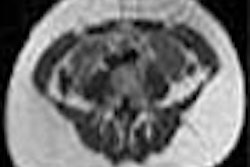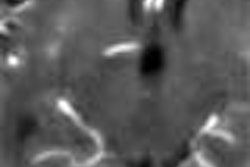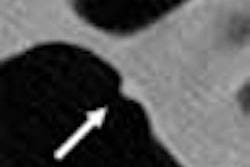Virtual colonoscopy is almost always performed in adults over 40, the population in which most colorectal polyps and cancers occur. Because the virtual exam is diagnostic only, without the therapeutic component of conventional colonoscopy, it is usually best applied in adult screening populations with a low probability of positive findings.
But there are times when virtual colonoscopy might make sense for children and young adults, too. For example, a child with juvenile polyposis might have to be screened with conventional colonoscopy as often as twice a year, enduring sedation, discomfort, and a small risk of perforation each time. Virtual colonoscopy could potentially be a better option.
At the 2003 Society for Pediatric Radiology conference in San Francisco, Dr. Sudha Anupindi from Massachusetts General Hospital in Boston discussed the use of virtual colonoscopy in six young patients aged 6.5 to 17 years (mean 9.1 years).
"The purpose of our study was to evaluate the technical feasibility of CT colonography (VC) in children without the use of sedation and contrast agents, utilizing a low-dose radiation technique, and then correlating our results with standard colonoscopy," she said. "Of the six patients, we had four with juvenile polyposis, one with a prior solitary benign polyp, and one with rectal bleeding of unknown etiology."
Along with her colleagues Dr. James Perumpillichira, Dr. Michael Zalis, Dr. Esther Israel, and Dr. Diego Jaramillo, Anupindi performed same-day virtual and conventional colonoscopy in each patient one to two days after standard bowel cleansing with magnesium citrate and various oral laxatives. Manual bowel insufflation was performed using room air (15-20 compressions) to the point where the patients said they "felt full," Anupindi said.
Scout images were acquired to test the adequacy of the insufflation and imaging technique. Abdominal multidetector-row CT images were then acquired in both prone and supine positions, with the children asked to breathe quietly rather than attempt to hold their breath.
"We used 3.75-mm slices, reconstructing them to 1.8 mm," Anupindi said. "The standard kVp was 120, and we used a range of mAs from 20 to 50 with a mean of 41.6. The information was analyzed on a 3-D Vitrea 2 workstation (Vital Images, Plymouth, MN), and by two radiologists, who reviewed both the axial and the endoluminal 3-D images."
The virtual colonoscopy results were not communicated to the pediatric gastroenterologists before they performed standard colonoscopy in each patient, including polyp resection and biopsies. No complications occurred in any patients for either procedure.
Virtual and conventional colonoscopy were negative in four patients and positive in two. One patient with positive findings was an eight-year-old girl with juvenile polyposis. Virtual colonoscopy found all five polyps detected in conventional colonoscopy, including three in the rectum, one in the rectosigmoid colon and one in the proximal transverse colon. The estimated polyp size on CT matched colonoscopy findings in four of the five polyps.
The fifth polyp, measuring 25 mm in the rectosigmoid colon, "was partially obscured by retained fluid in the colon, and only measured 5 mm on CT," Anupindi said.
A second patient had two polyps < 5 mm near the ileocecal valve, which were found with both examinations. If one discounts the large polyp that was underestimated in size, virtual colonoscopy's sensitivity was 100%.
The estimated effective radiation doses ranged from 1.39 mSv to 3.7 mSv, trending slightly higher in the female patients as expected. For comparison purposes, double-contrast barium enema would have resulted in exposure of 4.5 to 5 mSv for the average-sized children, and up to 8 mSv for the adolescent, Anupindi said. In one patient there was an incidental CT finding of a complex adnexal cystic mass that turned out to be a benign dermoid, in addition to large splenic cysts.
As for limitations, the sample size was small, and the interpretation times long. "Certainly that could be minimized as we become more experienced and more adept at reading these," she said, adding that "small lesions, less than 5 mm, are difficult to identify."
The future of virtual colonoscopy lies in optimizing the technique and increasing its acceptability, paving the way for larger patient cohorts, she said. "We hope to eventually eliminate the rigorous colon prep which is cumbersome for the children, and eventually use a positive oral contrast agent, which is a stool-tagging technique."
Still, the results correlated well with standard colonoscopy, and yielded lower radiation doses than a typical double-contrast barium enema exam, Anupindi said. Virtual colonoscopy was found to be safe, well tolerated, and useful for the evaluation of children.
By Eric BarnesAuntMinnie.com staff writer
June 13, 2003
Related Reading
Prepless virtual colonoscopy shows early promise, June 3, 2002
Copyright © 2003 AuntMinnie.com



















